Bat-GroundTwenty-eight species of bats call Arizona home. To many people, this is not good news as bats can conjure up images of vampires and haunted houses. Most of the impressions and feelings that people have about bats are derived from myth, horror movies and sensationalized media stories. These sources usually portray bats as evil or associate them with death and disease. In reality, bats are very beneficial to the environment. Nectivorous BatsTwo species of nectar-feeding bats, the Mexican long-tonged and the lesser long-nosed bats, can play a vital role in the pollination of saguaros and other cacti. Nectar-feeding bats differ from most other species of bats by having an longated muzzle, small nose and long tongue. These features allow them to reach deep inside the saguaro flowers. The flowers are pollinated as the bats travel from blossom to blossom. To assist in this symbiotic relationship, the large, creamy white, strongly-scented flowers open at night, aiding the bats in finding them in the dark. 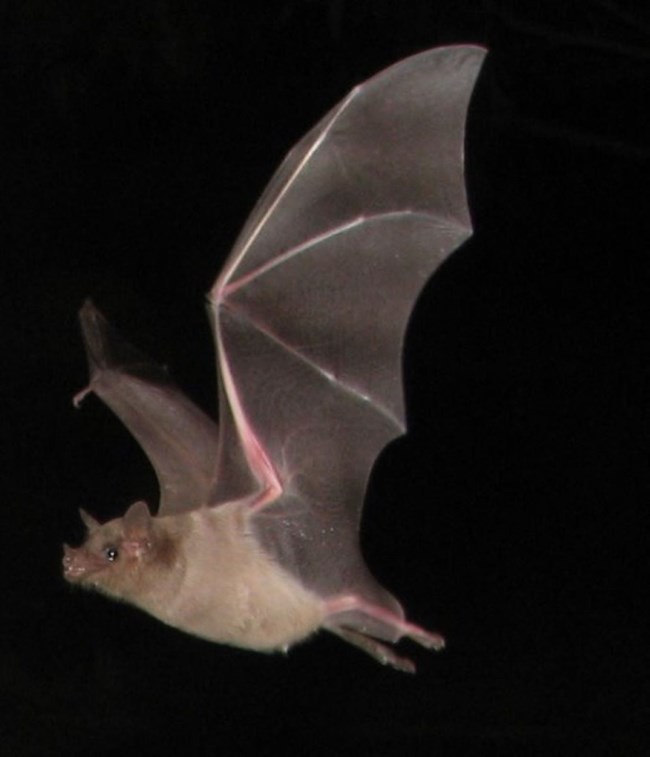
NPS Photo Lesser Long-nosed Bat (Leptonycteris curasoae)This summer visitor to Saguaro National Park arrives just in time for the flowering of the Saguaro cactus. The lesser long-nosed bat migrates north along the west coast of Mexico, feeding at the flowers of the cardon cactus, organ pipe cactus, and other plants that accommodate bat pollinators. The flowers of these plants have flowers high above the ground; they are lightly colored, visible at night, and promise a meal of pollen and nectar. 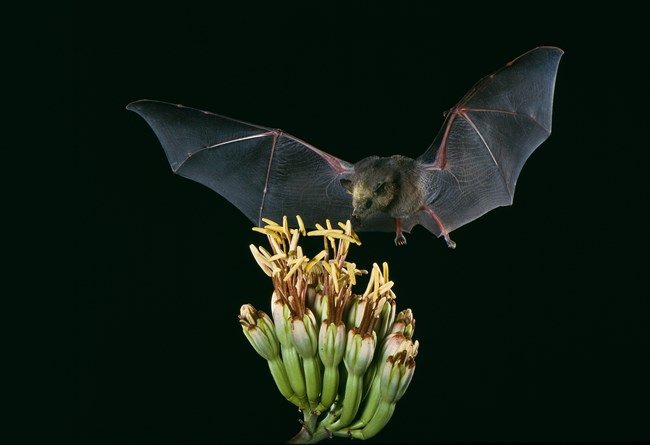
NPS Photo Mexican Long-tongued Bat (Choeronycteris mexicana)This migratory, nectar and pollen-feeding bat depends on plants adapted for bat pollination (like the agave). The Mexican long-tongued bat follows the flowering agave northward during the spring, arriving in Arizona in early summer. The agave gets a pollinator that transports its pollen, while the bat gets a meal of rich nectar and protein-filled pollen. To make it even easier on the bat, the flowers are thrust high into the sky, light colored, and easily spotted at night. The Mexican long-tongued bat, as the name implies, has a long tongue tipped with brush-like projections for lapping nectar. Insectivorous Bats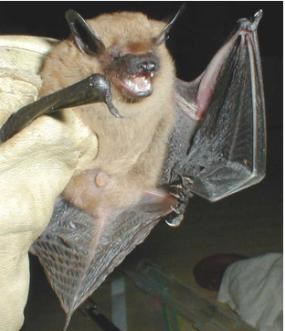
NPS photo Big Brown Bat (Eptesicus fuscus)This large bat is very common throughout its range, especially near farms and urban areas. In deserts, it generally roosts in man-made structures, although it has been documented roosting in woodpecker holes in saguaros. A fast flyer, it forages for insects during the summer and migrates to higher elevations to hibernate during winter. 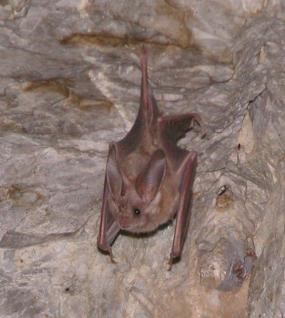
NPS photo California Leaf-nosed Bat (Macrotis californicus)The California leaf-nosed bat inhabits desert scrub of the Sonoran and Mojave Deserts. During the day, it roosts in caves and mineshafts, and at night, it hunts insects. Its hearing is so acute that it can hear noises as faint as the footstep of a cricket! It feeds on large insects that it plucks from foliage or directly off the ground. It does not land on the ground but hovers above its prey before striking. After catching its prey, the California leaf-nosed bat carries it to an open roost to feast. This species does not migrate or hibernate. Instead, it survives cold periods in the warmth of cave and mineshaft roosts. 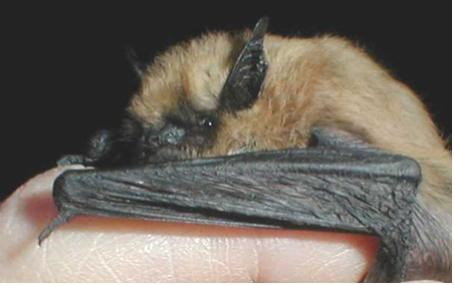
NPS photo California Myotis (Myotis californicus)The California myotis bat forages for small flying insects over desert scrub vegetation. It roosts during the daytime in buildings, under bridges, or under tree bark. Some individuals hibernate in mines and caves during winter months, while others remain active. Females form small breeding colonies of only a few individuals.
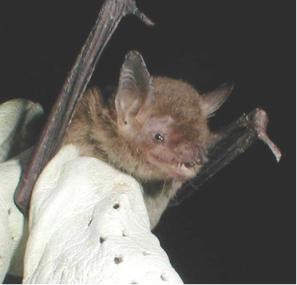
NPS photo Cave Myotis (Myotis velifer)This bat is found throughout the Sonoran Desert except for the driest, westernmost parts. Females sometimes form very large maternity colonies of about 15000 individuals. 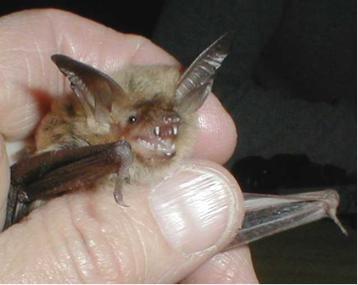
NPS photo Fringed Myotis (Myotis thysanodes)This colonial bat is active from April through September. The birth of young is synchronized throughout the colony. This myotis migrates to a winter roost, but its winter habits are not well known. 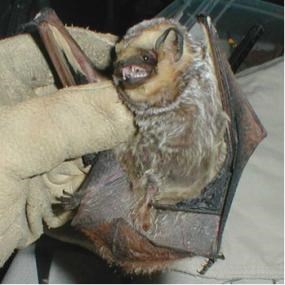
NPS photo Hoary Bat (Lasiurus cinereus)This bat species is widely distributed across the U.S. and southern Canada. During the summer, male hoary bats are found in the southwestern U.S., while females are spread over the entire bats’ range. In the fall, females meet up with the males in the Southwest, and both migrate to Mexico or South America. Presumably, mating takes place during migration or winter. 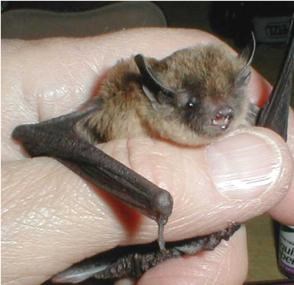
NPS photo Long-legged Myotis (Myotis volans)The long-legged myotis is a long-lived bat that can reach an age of 21 years. Females form maternity colonies of up to several hundred individuals which disperse in the fall. 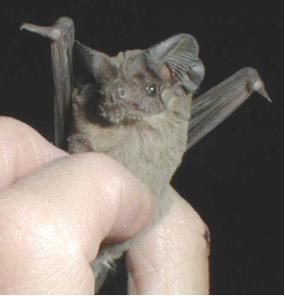
NPS photo Mexican Free-tailed Bat (Tadarida brasiliensis)The Mexican free-tailed bat, also known as the Brazilian free-tailed bat, is the most common bat in the Southwest with a U.S. population of over 100 million! They live in huge cave colonies where they squeeze in next to each other in densities of 2700 per square meter. Unlike most bats, young Mexican free-tailed bats roost separately from their mothers. The mother can recognize her youngster by its voice alone. Mexican free-tailed bats are strong and fast flyers. They can fly at speeds of 100 km (60 mph) and fly as far as 80 km (50 miles) from their roosts. Some of the local population hibernate, but most migrate to Mexico for the winter. 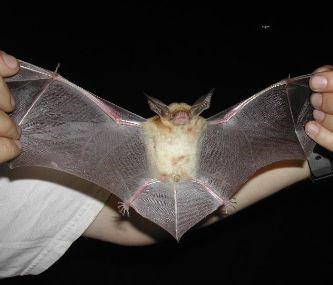
Photo courtesy of USGS Pallid Bat (Antrozous pallidus)The pallid bat flaps its wings more slowly than most bats. It forages low to the ground, landing frequently to catch large insects and invertebrates. Sometimes, they even get caught in mouse traps! Its hearing is so acute that it can hear the footsteps of insects on the ground. When disturbed, the pallid bat emits a skunk-like odor from the glands on its muzzle. Found across much of the western U.S. from Mexico to British Columbia, it roosts in colonies of 12 to 200 individuals. 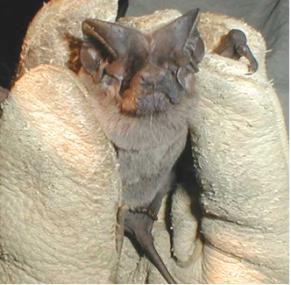
NPS photo Pocketed Free-tailed Bat (Nyctinomops femorosaccus)The female pocketed free-tailed bat mates just prior to ovulation in the spring. It roosts in rocky areas – crevices, overhangs, and sometimes caves. At night it gives a loud, high-pitched call when it drops from its roost. It also calls frequently from its day roost. 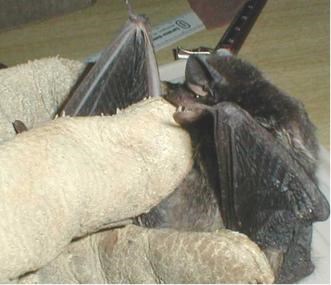
NPS photo Silver-haired Bat (Lasionycteris noctivagans)Named for the silver-tipped hairs on its back, this solitary, slow flying, tree-roosting species is found in both deciduous and coniferous forests. The silver-haired bat roosts under bark, in woodpecker holes, or in other protected spots. It is unknown whether females form maternity colonies or remain solitary before giving birth. 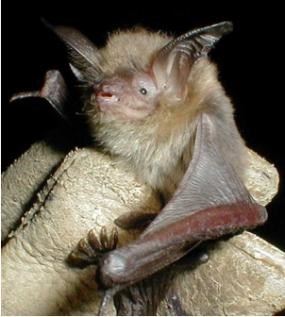
NPS photo Southwestern Myotis (Myotis auriculus)Although the daytime roosts of southwestern myotis bats are unknown, we do know that they roost in buildings and caves at night. They catch their prey of flying insects in mid-flight. 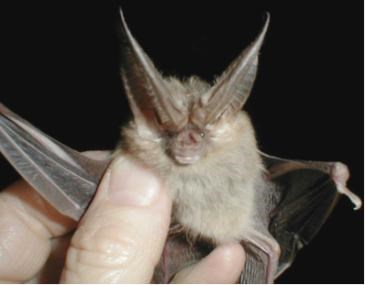
NPS photo Townsend’s Big-eared Bat (Corynorhinus townsendii)In the western U.S., female Townsend’s big-eared bats form maternity colonies of up to 200 individuals. Young bats are large, weighing about one quarter their mother's weight at birth. They can fly by three weeks of age. By day, Townsend’s big-eared bats hang from the ceilings of mines and caves. They hibernate in cold caves and mines, folding their huge ears back to the middle of their body.
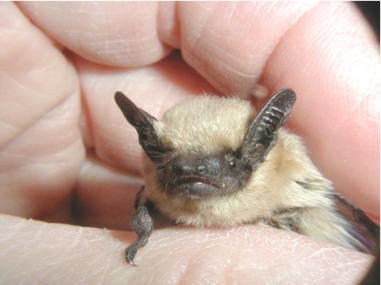
NPS photo Western Pipistrelle (Pipistrellus hesperus)The western pipistrelle is the smallest bat in the U.S., weighing about 3 grams (0.1 oz). It is buff in color with black ears, wings and tail membrane. A desert forager, it is usually the first bat to appear in the evening, usually well before dark. It roosts in caves, mines, and buildings. During warm winter evenings male bats can often be seen foraging over the desert floor while female western pipistrelles are hibernating at higher, cooler elevations. 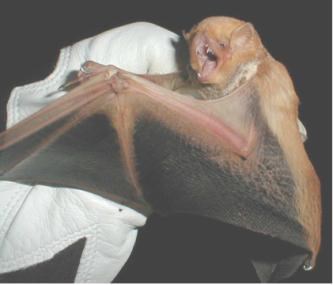
NPS photo Western Red Bat (Lasiurus blossevillii)Named for the rusty red coloration on its head and back, the western red bat also has white shoulder patches. Male bats are brighter than females in color. This solitary bat roosts in the dense foliage of deciduous trees. Western red bats migrate, often in flocks, to the southern parts of their range in winter. Western Small-footed Myotis (Myotis ciliolabrum)Little is known about the western small-footed myotis. It tends to forage along cliffs and rocky slopes. Maternity colonies are small and usually in man-made structures. Females bear only one offspring per year. Yuma Myotis (Myotis yumanensis)The Yuma myotis is closely associated with water. It feeds by flying low over water sources, snatching up small flying insects. Maternity colonies form in places with high temperatures, such as caves, buildings, tree cavities, or under bridges and can contain thousands of individuals. |
Last updated: May 5, 2025
